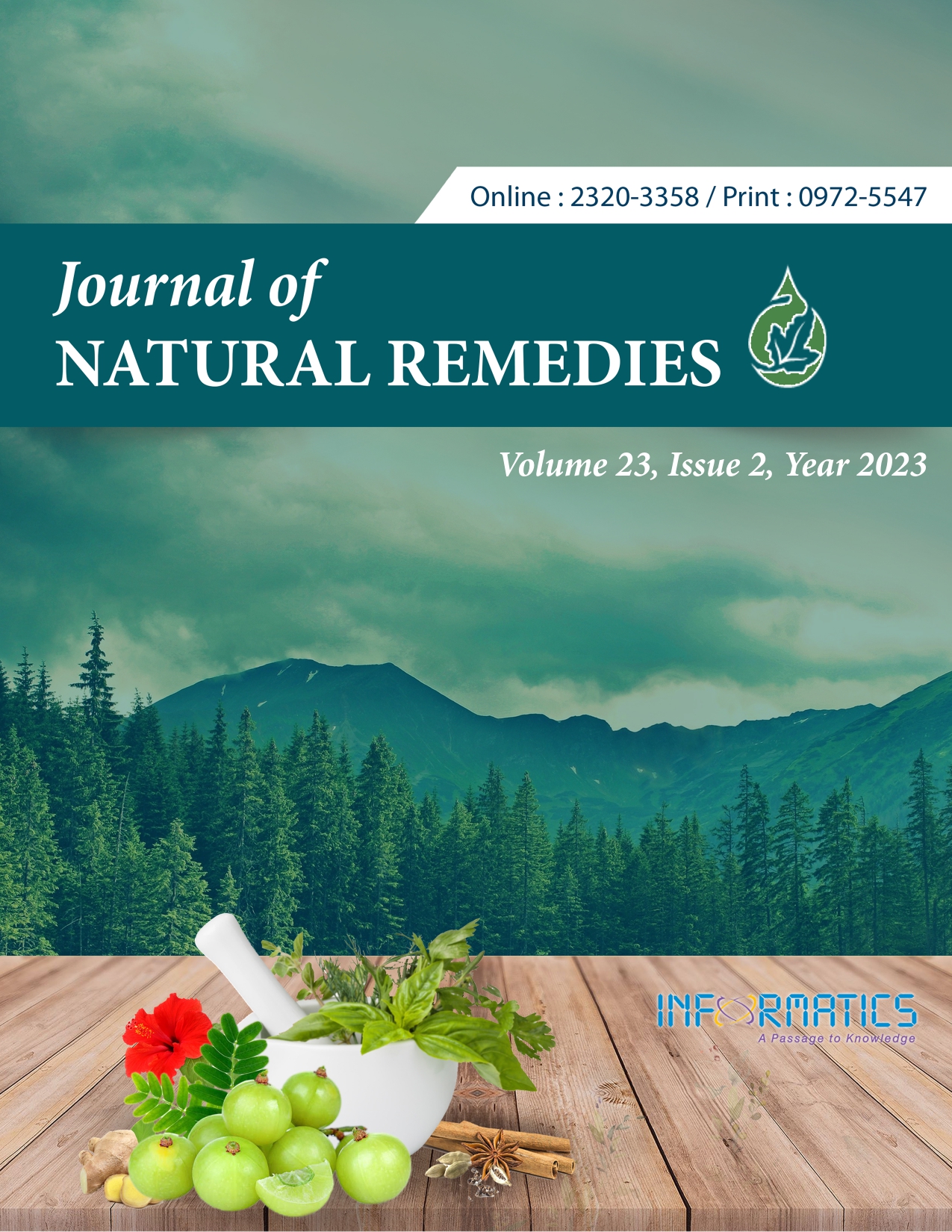Reformed Hormonal Status in Hyperandrogenism through Ayurvedic Management with Yoga and Prānāyāma in a Known Case of Polycystic Ovarian Syndrome - A Case Report
DOI:
https://doi.org/10.18311/jnr/2023/30884Keywords:
Ayurveda, Case Report, Elevated Luteinizing Hormone, Hyperandrogenism, LH: FSH, PCOSAbstract
Polycystic Ovarian Syndrome is the commonest endocrinological disorder of women in the reproductive age group. It is characterized by oligo/anovulation, hyperandrogenism, and raised Luteinizing Hormone: Follicle Stimulating Hormone ratio. Elevated levels of Luteinizing Hormone, contribute to hyperandrogenism and the altered ratio between Luteinizing Hormone and Follicle Stimulating Hormone. The present case report discusses the Ayurvedic management of altered Luteinizing Hormone - Follicle Stimulating Hormone ratio in a diagnosed case of Polycystic Ovarian Syndrome. The patient was diagnosed as having Ārtava Kṣaya with Mukhadūṣikā and was subjected to Ayurvedic management for 6 months commencing with Śodhana followed by Śamana. A remarkable improvement was obtained after the course of treatment.
Downloads
Metrics
Downloads
Published
How to Cite
Issue
Section
License
Copyright (c) 2023 Hemavathi Shivapura Krishnaraja Bhatt, Praseeda S, Gopika P, Parvathy Unnikrishnan, Anjaly Muraleedharan

This work is licensed under a Creative Commons Attribution 4.0 International License.
Accepted 2023-04-24
Published 2023-06-13
References
DC Dutta. D.C. Dutta’s Text Book of Gynecology, 8th edition. New Central Agency, Kolkata. 2020; 384-385:388.
Jeshica Bulsara, Priyanshi Patel, Arun Soni, Sanjeev Acharya. A review: Brief insight into Polycystic Ovarian Syndrome. Endocrine, and Metabolic Science. 2021; 3:100085. ISSN 2666-3961. https://doi.org/10.1016/j.endmts.2021.100085 DOI: https://doi.org/10.1016/j.endmts.2021.100085
Sirmans SM, Pate KA. Epidemiology, diagnosis, and management of polycystic ovary syndrome. Clin Epidemiol. 2013; 18(6):1-13. https://doi.org/10.2147/CLEP.S37559 DOI: https://doi.org/10.2147/CLEP.S37559
Azziz R. Polycystic Ovary Syndrome. Obstet Gynecol. 2018; 132(2):321-336. https://doi.org/10.1097/AOG.0000000000002698 DOI: https://doi.org/10.1097/AOG.0000000000002698
Saadia Z. Follicle Stimulating Hormone (LH: FSH) ratio in Polycystic Ovary Syndrome (PCOS) - obese vs. non-obese women. Med Arch. 2020; 74(4):289-293. https://doi.org/10.5455/medarh.2020.74.289-293 DOI: https://doi.org/10.5455/medarh.2020.74.289-293
Vaidya Jadavji Trikamji Ācārya, Suśruta Saṃhita, Nibandhasamgraha Commentary of Shri Dalhanācārya and Nyayacandrikapanjika of Sri Gayadasācārya, Chaukamba Orientalia Publishers, Varnasi, Sutrasthāna; 9th ed. 2007; 15/12:70.
Murthy KRS. Sharangdhara Samhita;reprint edition. Varanasi: Chaukumba Orientalia; 2010. p. 109.
Vaidya Jadavji Trikamji Ācārya, Suśruta Saṃhita, Nibandhasamgraha Commentary of Shri Dalhanācārya and Nyayacandrikapanjika of Sri Gayadasācārya, Chaukamba Orientalia Publishers, Varnasi, cikista sthāna; 9th ed. Reprint. 2017; 18/4:470.
Ācārya Vāgbhaṭa. Ashtanga Hridaya, commentaries of Sarvangasundara of Arunadatta and Ayurveda Rasāyana of Hemadri, Chaukamba Subharati Prakashan, Varānasi, Uttarasthana. 34(63-64):899-901.
Pt Hari Sadasiva Sastri Paradakara, editor. Ashtanga Hrdaya of Vagbhata, Uttarasthana, Edition: Reprint. Chaukhamba Sanskrit Sanshthana,Varanasi. 2020; 34(45-48):900.
Vanitha M, Meera S. Fertility effect of ayurvedic medicine (Phala Sarpis) in animal model. International Journal of Research in Ayurveda and Pharmacy. 2012. https://doi.org/10.7897/2277-4343.03517 DOI: https://doi.org/10.7897/2277-4343.03517
Donga KR, Donga SB, Dei LP. Role of Nasya and Matra Basti with Narayana Taila on anovulatory factor. Ayu. 2013; 34(1):81-5. PMID: 24049410; PMCID: PMC3764886. https://doi.org/10.4103/0974-8520.115453
Bhavamisra, Bhavaprakasa Nighantu. Varānasi: Chaukamba Bharati Academy; 2006. p. 65.
Narayanan Vaidyar, Sahasra yogam, Ashoka Pharmacy Kannur, 1st ed; 2001. p. 58.
Sri Sadaananda Sharma, Rasatarangini, Chaukhamba Surbharati Prakashan, First ed. 2015; 8(36-38):125.
Kumari A, Tewari P. Yogaratnaakara, Chaukhamba Visvabharati, Rasaayanaadhikara. 1st ed. 2010; 76:1245.
Tripathi R. Ashtanga Samgraha of Vriddha Vagbhatta, Sutra Sthana. Revised edition. Delhi: Chaukhamba Sanskrit Pratishthana. 1992; 29(6):531.
Vaidya Jadavaji Trikamji Acharya, Editor. Charaka Samhita of Agnivesa, Sutrasthana, Chaukamba Orientalia Publishers, Varnasi, Sutrasthāna; 9th ed. 2009; 5(56-62):41.
Donga KR, Donga SB, Dei LP. Role of Nasya and Matra Basti with Narayana Taila on anovulatory factor. Ayu. 2013; 34(1):81-5. https://doi.org/10.4103/0974-8520.115453 DOI: https://doi.org/10.4103/0974-8520.115453
Selvaraj V, Vanitha J, Dhanaraj FM, Sekar P, Babu AR. Impact of yoga and exercises on polycystic ovarian syndrome risk among adolescent schoolgirls in South India. Health Sci Rep. 2020; 3(4):e212. https://doi.org/10.1002/hsr2.212 DOI: https://doi.org/10.1002/hsr2.212
Ansari RM. Kapalabhati pranayama: An answer to modern day polycystic ovarian syndrome and coexisting metabolic syndrome? Int J Yoga. 2016; 9(2):163-7. https://doi.org/10.4103/0973-6131.183705
Streeter CC, Gerbarg PL, Saper RB, Ciraulo DA, Brown RP. Effects of yoga on the autonomic nervous system, gamma-aminobutyric acid, and allostasis in epilepsy, depression, and post-traumatic stress disorder. Med Hypotheses. 2012; 78(5):571-9. https://doi.org/10.1016/j.mehy.2012.01.021 DOI: https://doi.org/10.1016/j.mehy.2012.01.021
Yogiswatmarma, Hatha Yoga pradipika, commentary by Sami Mukktibodananda, Yoga Publications Trust, Bihar, Reprint. 2014; 1(27-29).
Sengupta P. Health impacts of yoga and pranayama: A state-of-the-art review. Int J Prev Med. 2012; 3(7):444-58. PMID: 22891145; PMCID: PMC3415184.
Ansari RM. Kapalabhati pranayama: An answer to modern day polycystic ovarian syndrome and coexisting metabolic syndrome? Int J Yoga. 2016; 9(2):163-7. https://doi.org/10.4103/0973-6131.183705 DOI: https://doi.org/10.4103/0973-6131.183705

 S. Praseeda
S. Praseeda









 0.35
0.35 24
24 0.161
0.161